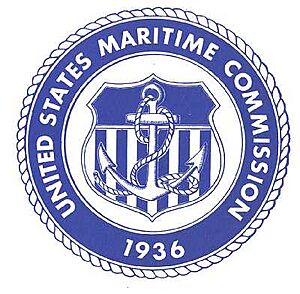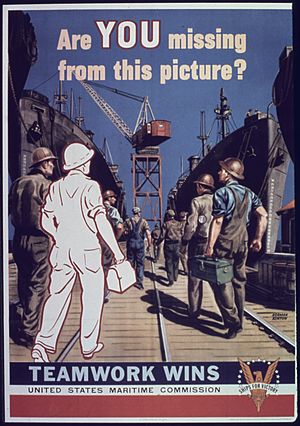United States Maritime Commission facts for kids
The United States Maritime Commission (often called MARCOM) was a special government group in the United States. It was created on June 29, 1936, by a law called the Merchant Marine Act of 1936. MARCOM's main job was to help the U.S. build and manage its merchant ships. These are ships that carry goods and people, not military ships.
Before MARCOM, there was another group called the United States Shipping Board. MARCOM took over its work. One big goal was to design and build 500 new, modern cargo ships. This was to replace older ships from World War I.
MARCOM also helped pay for building ships in the U.S. and for operating them under the American flag. This was done to make sure U.S. shipping companies could compete with foreign ones. They also started the United States Maritime Service to train sailors and officers for the new ships.
A famous ship, the SS America, was one of the first built under this new plan. It showed the rebirth of American shipping.
From 1939 through World War II, MARCOM led the biggest shipbuilding effort in history. They built thousands of ships, like Liberty ships, Victory ships, and T2 tankers. By the end of the war, U.S. shipyards had built 5,777 ocean-going ships for trade and the navy.
After the war, many ships were sold to other countries. MARCOM's last big project was overseeing the design of the super passenger ship SS United States. This ship was meant to show America's power and could also quickly become a fast troop transport.
The Maritime Commission closed down on May 24, 1950. Its jobs were split between two new groups: the U.S. Federal Maritime Commission and the United States Maritime Administration.
Contents
How the Maritime Commission Started
Why MARCOM Was Created
The Maritime Commission had several important goals. First, it needed to create a plan to build 900 modern, fast cargo ships over ten years. These ships would replace the older ones from World War I.
These new ships were meant to be leased to U.S. shipping companies. This would help them offer better and cheaper services to their customers. The ships could also be used by the navy if there was a war.
Another key job was to manage a system that helped pay for building and operating ships in the U.S. This helped American companies compete. MARCOM also started the United States Maritime Service to train officers and sailors for the new fleet.
Before World War II
President Franklin D. Roosevelt chose Joseph P. Kennedy Sr. to be the first head of the Commission. Kennedy led the group until February 1938. After he left, Rear Admiral Emory S. Land took over.
Admiral Land brought in Commander Howard L. Vickery. Vickery was in charge of designing and building the new ships. He also helped develop shipyards and factories to make ship parts. As World War II got closer, Vickery helped start the Emergency Shipbuilding Program. This program led to a huge increase in wartime ship production.
The SS America was the first ship built under the new plan. It showed the new strength of the U.S. Merchant Marine. Many more ships were built before the war. By late 1940, it became clear how important MARCOM was for defending the supply lines to Great Britain. All of MARCOM's shipbuilding efforts were known as "Ships for Victory." Many thousands of Americans worked hard in shipyards to build these vessels.
During World War II
From 1939 until the end of World War II, the Maritime Commission managed the largest shipbuilding effort ever. They built thousands of merchant ships. These included famous types like Liberty ships, Victory ships, and T2 tankers. Many of these ships were also changed to serve the Navy.
The Commission also built hundreds of military ships. These included Landing Ship, Tanks (LSTs) and Tacoma-class frigates. By the end of the war, U.S. shipyards had built a total of 5,777 ships.
In 1942, the training and licensing of sailors moved to the United States Coast Guard. Later that year, the Maritime Service moved to the new War Shipping Administration (WSA). The WSA was created to manage the huge fleet of merchant ships being built for the war. Admiral Land led both MARCOM and the WSA, so they worked very closely.
After World War II
After World War II ended, the shipbuilding programs stopped. There were now too many merchant ships for peacetime needs. In 1946, a law called the Merchant Ship Sales Act was passed. This allowed the U.S. to sell many of its wartime ships to other countries.
This helped countries like Great Britain, Norway, and Greece rebuild their fleets. These nations had lost many ships during the war. Even former enemy nations like Japan received help. U.S. ships carried aid to war-torn Europe. For many years after the war, ships built by MARCOM could be seen in ports worldwide. Many continued sailing until the 1980s.
Ships that were not sold were put into special storage areas called the National Defense Reserve Fleet (NDRF). These "mothballed" ships could be used again if needed. They were activated for military and aid missions several times, including during the Vietnam War. Today, a smaller group of ships called the Ready Reserve Force is used for similar missions.
The SS United States
The last big project for the Commission was overseeing the design and building of the super passenger ship SS United States. This ship was a symbol of American power. It was also designed to be quickly changed into the world's fastest troop transport ship for the Navy.
MARCOM Closes Down
The Maritime Commission was officially closed on May 24, 1950. Its responsibilities were split between two new groups. The U.S. Federal Maritime Commission took over regulating shipping. The United States Maritime Administration (MARAD) became responsible for shipbuilding programs, maintaining the NDRF, and running the U.S. Merchant Marine Academy. This academy, built during World War II, still trains future merchant marine officers today.
Important Dates
- 1936: The Merchant Marine Act creates the Maritime Commission.
- 1937: Joseph P. Kennedy Sr. becomes the first head of the Commission.
- 1938: The Maritime Commission plans to build a large merchant fleet.
- 1940: MARCOM agrees to build 60 ships for the British.
- 1941: The Emergency Shipbuilding Program begins.
- 1942: The War Shipping Administration is created.
- 1942: The United States Coast Guard takes over marine inspection.
- 1942: The United States Merchant Marine Academy opens in Kings Point, New York.
- 1942: The Maine Merchant Marine Academy (now Maine Maritime Academy) opens.
- 1950: The Maritime Commission's jobs move to the United States Department of Commerce and MARAD.



